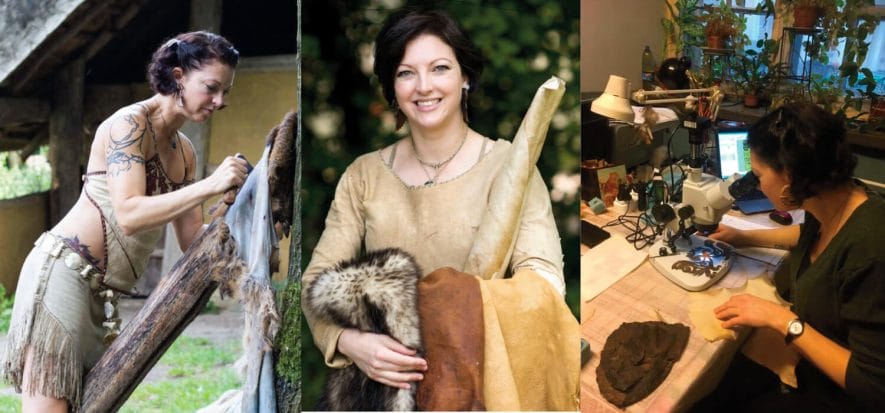Her name is Theresa Emmerich Kamper. A native of Wyoming, she graduated in Experimental Archeology, and then specialised in prehistoric and historical leather tanning technologies up to the creation of artefacts. To this, she combines her passion for primitive life; she has also participated in some reality shows to demonstrate how humans lived during the Stone Age. In the middle of the woods, she organises courses on how to tan wild animals’ leather. When you think or say that “leather has accompanied the evolution of the human race since the dawn times”, that’s it, she is the living proof. How could we not interview her?
Thus, I teach prehistoric tanning
What is the purpose of your research?
The main objective is to identify the different prehistoric tanning technologies based on the macroscopic and microscopic differences in the visual characteristics. The secondary one is public education and scientific dissemination on prehistoric leather processing technologies.
Why this choice?
I have dressed in leather since I was 11 years old: it is a passion that has lasted for a lifetime! I have undertaken a Masters in Experimental Archeology at the University of Exeter, UK. There, I decided to specialise in leather analysis. I noticed that there were few studies on archaeological objects made of leather. And that some had been written by those who were unfamiliar with the tanning processes used in prehistoric times, for example oil tanning, bath tanning and, also, vegetable tanning.
The perception of leather
How is leather perceived by the people with whom you talk about?
I often work in open-air museums, doing demonstrations and scientific dissemination on leather processing in prehistoric times. Most of the audience is fascinated by the process. When they think of leather, they think of high fashion, jackets, shoes, bags. Thus, they are often surprised to see that, with the same raw leather and varying only its processing, it is possible to obtain sheets, containers for drinking and cooking.
What generates the greatest surprise in people?
When I explain that I can tan 20 hides with the same time it takes to produce a piece of fabric from nettle or flax fibers. Today, leather is seen as a luxury item, but when it was first produced, it was probably the other way around. Fabric was a rare resource, while leather was used for everyday items.
The future of leather
What is the future of leather?
Leather will always have a place in our culture. It is what has allowed our species to migrate out of temperate climates, to explore and settle in environments where it would have been impossible to survive without the protection provided by fur and leather. It is as much a part of human history as the manufacture of stone tools and fire.
Today, however, the context is different…
Clearly: we need to emphasise sustainability and the use of local resources. For example, now more than ever, I notice that a niche is being created for small-scale artisan leather producers.
What do you think of “alternative” and “vegan” materials?
I have nothing against them. However, the fact that they do not use animal raw materials does not make them ecological by definition. There is no way around the fact that an animal dies and, therefore, produces leather. Leather that, today, can be tanned in an ecological way. There is more: the items I produce must meet a number of criteria, one of which is historical accuracy, something that an alternative to leather can hardly achieve.
Amazement and Italy
Regarding your museum experience, what are the leather objects that really surprised you?
I have had the privilege of working with some amazing leather items! I recently analysed a cheese bag made of Shia leather, found at the Hermitage Museum in St. Petersburg, Russia. It had a lid made from a mosaic of furs some of which are dyed blue. It’s an amazing piece of art, but it’s also a fully functional object.
Another one?
An ethnographic container of the North American Arctic. It was made with an incredible variety of animal products and different types of tanning. Using such a variety of animal-based resources really highlights the beautiful ethics of using whatever your surroundings can provide. Combining it to make an object that is both beautiful and useful at the same time.
What is your relationship with Italy?
I haven’t worked in Italy very often, but I hope to do it in the future. I did a series of demonstrations and a presentation for the Paleofestival in La Spezia, in 2018. The following year, I presented a research in Trento for the Experimental Archeology conference, organised every two years by EXARC. And in the future, I could hold workshops or demonstrations focusing on the different tanning technologies associated with Oetzi’s clothing and equipment.
Read also:











